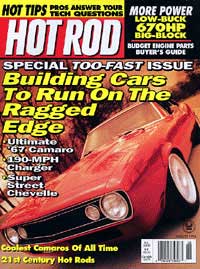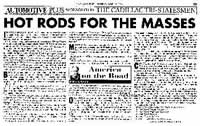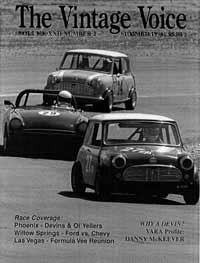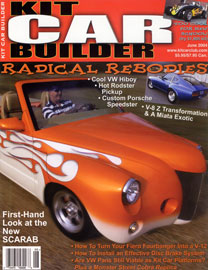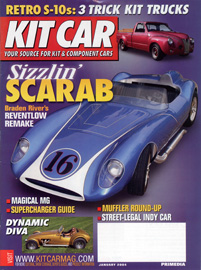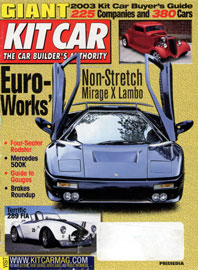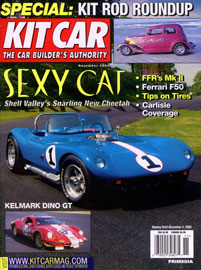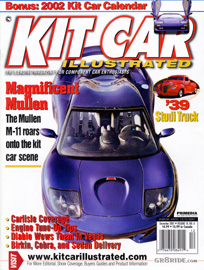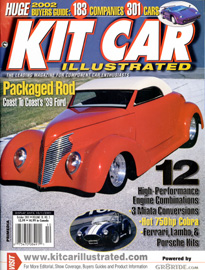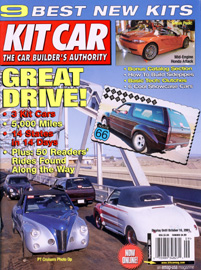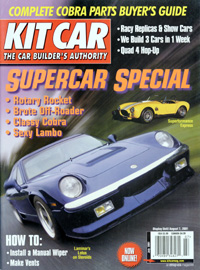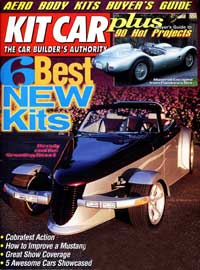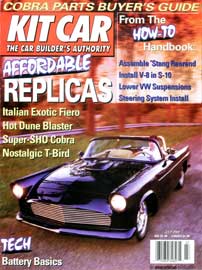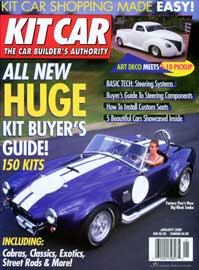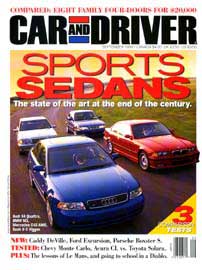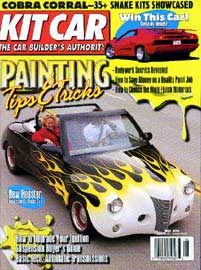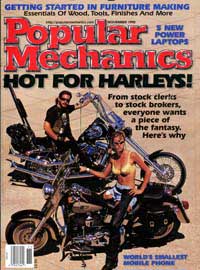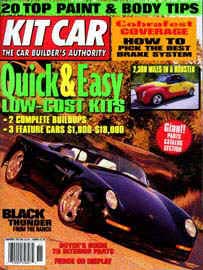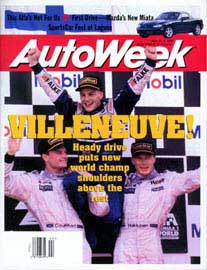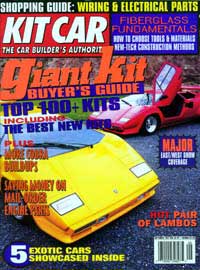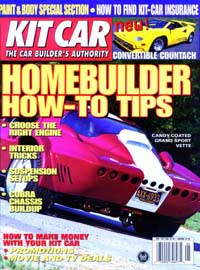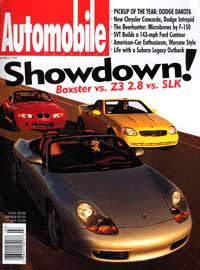What
is the Rodster®?
© Copyright Caroselli.
No images or text located anywhere on this site may be reused
or republished without expressed written permission from Rodster,
Inc., d.b.a.: Caroselli Design. The Rodster Street Rod design
is protected by
U.S. Patent # D450,284.
"Rodster®" is a registered
trademark of Caroselli Design. |
What
is Kit Car Illustrated saying
about the Rodster® street rod?
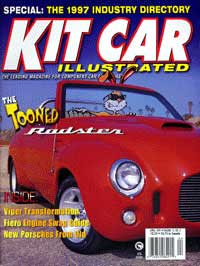 Kit
Car Illustrated
Kit
Car Illustrated
by Bill Moore
For years now there has been a split between the hot rodders and those who built kit cars. Those who build hot rods -- no joke -- think they're better. And while that's not necessarily true, they do feel that way despite the fact that they too use fiberglass bodies.
Hoo-Boy!
The closest thing to the hot rod era that Henry Caroselli got to while growing up in Michigan was drag-racing between stop lights on Woodward Avenue. Oh, and for those who want a timeline, that was as a teenager in the late Sixties.
He doesn't know anything about 60-year-old ferrous oxide, and if you've got a real steel-bodied automobile from 1932, that's what you've got -- rust. Or, it isn't the same Bessemer transformed iron ore from the steel mills of 1931.
Henry, as a talented guy, knows about fiberglass and form -- as it follows function. So, the form he has created is made from flawless fiberglass -- some of the best stuff we've ever seen. But the shape of this thing he calls a Rodster, from the combination of hot rod and roadster, is all his own even if it is a rough compilation of things he saw in STREET RODDER magazine over the years.
You see, while the Rodster resembles something from the Thirties or Forties, it's as fresh an automobile shape as Roger Rabbit was a movie! You see, the fact is that he uses a Chevy S-10 Blazer as the donor vehicle for his Rodster, and that has dictated certain aspects of its overall design. While Henry wanted to give enthusiasts an easy-to-build vehicle which would capture the hot rod look, he also wanted to make sure it was something you could afford and drive on a daily basis.
And, at $3,995 for the basic kit and $5,795 for the deluxe package, he has succeeded marvelously.
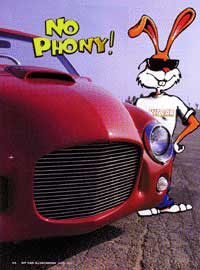
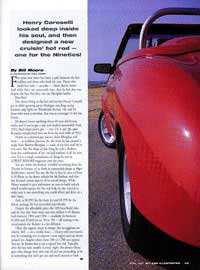
Despite the affordable price, the 10-hour build time and the fact that there were over two million S-10 Blazers built between 1982 and 1994 -- available for between $1,000 and $5,000 for an '82 to '89 -- all waiting to be transformed; the Rodster is a bit different.
Okay, the organic shape is strange, like an eggplant on wheels. Still -- on a weekly basis -- Henry rolls into harm's way by venturing out to massive cruise nights and car shows around Los Angeles where from 200 to 1,700 cars apppear. You see, he knows this is not a typical hot rod. Typically, after the hot rods rumble in every night, the drivers (those guys who change their own real oil and are pretending to be in something that isn't) get out and stroll around to look over the opposition and assure themselves of their own superiority. Eventually, they wander over to see Henry and his Rodster.
Being smart guys, the hot rodders know what this car is. "Say, what year Ford is that?" Or, "Is that a Chevy?" Or, some of the wives ask, "Is that a Prowler?"
"Well, no," explains Henry. "It's a Rodster, a kit you can build from a Chevy S-10 Blazer."
"Uh," says the hot rodder, "that's a kit?"
And so it goes.
And, well, the Rodster does go!
I stopped in and saw Henry the other day at his little shop in El Segundo (Spanish for "The Second", in honor of the fact that the oil refinery out his back door was the second refinery built in California.). He had a Rodster painted in red, and one in gray primer. (As a teenager, I personally felt that the gray primer was the most beautiful color in the world. How about you?).
That second car had a race number on it and more closely resembled the original hot rods that blossomed in California just before and after World War II. Those cars were lightened and then the biggest, most powerful engine possible was dropped in the nose. They were not all chromed like those cars that show up at cruise nights. They were there to go fast -- and the guys who were driving them were slow to spend money on chrome. At about 20 cents a gallon, a buck -- maybe two -- would get you a night on the town and maybe a couple of burgers.
In any case, I got to drive the lovely little red machine. This 2,980-pound hot rod had a 180-horsepower, 4.3 liter engine and a four-speed automatic, straight out of a Blazer. The engine sits in a nose that had to be high enough to cover it, and -- of course -- Henry kept the same Blazer windshield. While that makes a Rodster easier to build, it does create an aesthetic problem. The windshield is abrupt. And, yeah, maybe the cowl is too high.
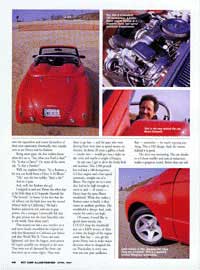
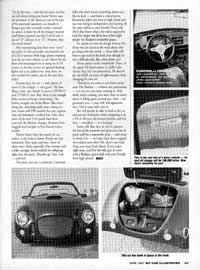
Of course, if you'd like to spend more money, you COULD chip the windshield and use a K&N remote air filter to lower the height of the engine cover. But, hey -- you get the point: Henry had to make major decisions when he designed this car. Practicality, in every case, won out over pure aesthetics. But -- remember -- he wasn't copying anything. This is HIS design. And, the reason behind it is good.The drive was interesting. The car, thanks to a Gibson muffler and ram air induction, makes a gorgeous sound. Better than any old '32, by the way -- and this no-muss, no-fuss car will always bring you home! Henry uses an automatic in the demo car just to be sure all his potential customers can handle it. Being a guy who normally works a manual six-speed, it didn't do all the things I wanted until Henry pointed out that I could take it out of "O" and put it in "D". Hmmm, that was much better!
After mentioning that there were "never" any poice in this particular area beyond one of LAX's runways (with huge planes straining into the air every minute or so), Henry let me loose and encouraged me to jump on it! Of course, at the first corner we spotted flashing lights and a car pulled over. And, then, we saw another five police cars in the next four miles!
Despite that, the car -- with plenty of room in the cockpit -- runs great. The handling is fine, too, thanks in part to 225/50-15 and 275/60-15 tires. But, there is just enough body motion to keep it interesting. The brakes, straight out of the Blazer (like everything else, including dash, seats, wiring system, frame and VIN number for easy registration and insurance) worked fine. And, since most of the steel S-10 panels have been removed, the Rodster changes divisions from sluggish heavyweight to fleet footed welter-weight.
Almost better than the sound the car makes, is the looks it draws. People are very interested. They stop, and stare. Some of them wave. Kids, especially. One woman with a baby carriage almost walked her offspring right into the street. Thumbs up! Sure. Lots -- and lots!
The draw, you see, is universal. Common folks who don't know everything about cars, like its look -- and that's a critical point. Remember when you were in high school and you were being so independent and wearing all the same clothes as your friends? Those who think they know what a hot rod is supposed to look like might not fall in love at first sight despite the Rodster's wonderul graces.
So, maybe it's time to change history. For those who are stuck in the mud, those who go along with the crowd -- those foks will have to get used to the look even though it's not a difficult task. But, what about you?
Henry points to the windshield. There, in the upper lef-hand corner, is a Jiffy-Lube sticker. Yup, he's not pretentious. He doesn't get any thrill, no sense of righteousness, from changing his own oil.
Ultimately, we come to our final conclusion: The Rodster -- without any pretensions -- is a car you can enjoy cruising in. And, while you're cruising, you won't have to worry about it falling apart around you. And -- we guarantee you -- your wife will appreciate that. That is your wife, isn't it?
But will people be able to look at the car and prevent themselves from comparing it to a 50- or 60-year-old memorymobile, and feel that -- somehow -- it is lacking?
Some will. But, hey, we feel it captures the fun of the moment and gives you a lot of good stuff for a reasonable price -- and come to think of it -- isn't that what those original hot rodders were after! Oh, there's one final thing you must think about: If you order right away, you'll be the only guy in town with a Rodster, and to hell with your friends from high school!
